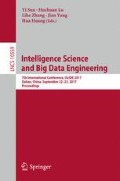Abstract
This paper introduces a novel saliency detection method by incorporating logistic regression into the label propagation framework, along with a principled weight computation for saliency fusion. First, the initial map is generated by computing objectness and backgroundness. Second, we unify logistic regression and label propagation to predict saliency labels. Last, we fuse the predicted result and initial map and further refine the fused map across multiple scales. Moreover, we use clustering random forest to learn the pairwise affinities between superpixels for backgroundness computation and saliency prediction. Extensive experiments on three large benchmark datasets demonstrate the proposed algorithm performs well against the state-of-the-art methods.
Access this chapter
Tax calculation will be finalised at checkout
Purchases are for personal use only
References
Kobayashi, T., Watanabe, K., Otsu, N.: Logistic label propagation. Pattern Recogn. Lett. 33(5), 580–588 (2012)
Borji, A., Itti, L.: State-of-the-art in visual attention modeling. IEEE Trans. Pattern Anal. Mach. Intell. 35(1), 185–207 (2013)
Triesman, A., Gelade, G.: A feature-integration theory of attention. Cogn. Psychol
Itti, L., Koch, C., Niebur, E.: A model of saliency-based visual attention for rapid scene analysis. IEEE Trans. Pattern Anal. Mach. Intell. 20(11), 1254–1259 (1998)
Goferman, S., Zelnik-Manor, L., Tal, A.: Context-aware saliency detection. In: Proceedings of IEEE Conference on Computer Vision and Pattern Recognition, pp. 2376–2383 (2010)
Kuen, J., Wang, Z., Wang, G.: Recurrent attentional networks for saliency detection. In: Proceedings IEEE Conference on Computer Vision and Pattern Recognition (2016)
Kim, J., Pavlovic, V.: A shape-based approach for salient object detection using deep learning. In: Proceedings of European Conference on Computer Vision, pp. 455–470 (2016)
Harel, J., Koch, C., Perona, P.: Graph-based visual saliency. In: Proceedings of Neural Information Processing Systems, pp. 545–552 (2006)
Jiang, B., Zhang, L., Lu, H., Yang, C., Yang, M.-H.: Saliency detection via absorbing Markov chain. In: Proceedings of IEEE International Conference on Computer Vision, pp. 1665–1672 (2013)
Zhu, X., Loy, C.C., Gong, S.: Constructing robust affinity graphs for spectral clustering. In: Proceedings IEEE Conference on Computer Vision and Pattern Recognition, pp. 1450–1457 (2014)
Grady, L., Jolly, M., Seitz, A.: Segmentation from a box. In: Proceedings of IEEE International Conference on Computer Vision, pp. 367–374 (2011)
Wei, Y., Wen, F., Zhu, W., Sun, J.: Geodesic saliency using background priors. In: Proceedings of European Conference on Computer (2012)
Alexe, B., Deselaers, T., Ferrari, V.: Measuring the objectness of image windows. IEEE Trans. Pattern Anal. Mach. Intell. 34(11), 2189–2202 (2012)
Yan, Q., Xu, L., Shi, J., Jia, J.: Hierarchical saliency detection. In: Proceedings IEEE Conference on Computer Vision and Pattern Recognition, pp. 1155–1162 (2013)
Li, Y., Hou, X., Koch, C., Rehg, J.M., Yuille, A.L.: The secrets of salient object segmentation. In: Proceedings of IEEE Conference on Computer Vision and Pattern Recognition, pp. 280–287 (2014)
Cheng, M., Mitra, N., Huang, X., Torr, P., Hu, S.-M.: Global contrast based salient region detection. IEEE Trans. Pattern Anal. Mach. Intell. 37(3), 569–582 (2015)
Tu, W.-C., He, S., Yang, Q., Chien, S.-Y.: Real-time salient object detection with a minimum spanning tree. In: Proceedings of IEEE Conference on Computer Vision and Pattern Recognition (2016)
Tong, N., Lu, H., Ruan, X., Yang, M.-H.: Salient object detection via bootstrap learning. In: Proceedings of IEEE Conference on Computer Vision and Pattern Recognition, pp. 1884–1892 (2015)
Li, C., Yuan, Y., Cai, W., Xia, Y., Feng, D.D.: Robust saliency detection via regularized random walks ranking. In: Proceedings IEEE Conference on Computer Vision and Pattern Recognition, pp. 2710–2717 (2015)
Zhu, W., Liang, S., Wei, Y., Sun, J.: Saliency optimization from robust background detection. In: Proceedings of IEEE Conference on Computer Vision and Pattern Recognition, pp. 2814–2821 (2014)
Li, X., Lu, H., Zhang, L., Ruan, X., Yang, M.-H.: Saliency detection via dense and sparse reconstruction. In: Proceedings of IEEE International Conference on Computer Vision, pp. 2976–2983 (2013)
Yang, C., Zhang, L., Lu, H., Ruan, X., Yang, M.-H.: Saliency detection via graph-based manifold ranking. In: Proceedings of IEEE Conference on Computer Vision and Pattern Recognition, pp. 3166–3173 (2013)
Cheng, M., Warrell, J., Lin, W., Zheng, S., Vineet, V., Crook, N.: Efficient salient region detection with soft image abstraction. In: Proceedings of IEEE International Conference on Computer Vision, pp. 1529–1536 (2013)
Jiang, P., Ling, H., Yu, J., Peng, J.: Salient region detection by UFO: uniqueness, focusness and objectness. In: Proceedings of IEEE International Conference on Computer Vision, pp. 1976–1983 (2013)
Shen, X., Wu, Y.: A unified approach to salient object detection via low rank matrix recovery. In: Proceedings of IEEE Conference on Computer Vision and Pattern Recognition, pp. 853–860 (2012)
Jiang, H., Wang, J., Yuan, Z., Liu, T., Zheng, N., Li, S.: Automatic salient object segmentation based on context and shape prior. In: Proceedings of British Machine Vision Conference (2011)
Chang, K.-Y., Liu, T.-L., Chen, H.-T., Lai, S.-H.: Fusing generic objectness and visual saliency for salient object detection. In: Proceedings of IEEE International Conference on Computer Vision, pp. 914–921 (2011)
Acknowledgement
This work is supported by the Natural Science Foundation of China #61371157.
Author information
Authors and Affiliations
Corresponding author
Editor information
Editors and Affiliations
Rights and permissions
Copyright information
© 2017 Springer International Publishing AG
About this paper
Cite this paper
Ai, J., Zhang, L., Li, X. (2017). Saliency Detection by Unifying Regression and Propagation. In: Sun, Y., Lu, H., Zhang, L., Yang, J., Huang, H. (eds) Intelligence Science and Big Data Engineering. IScIDE 2017. Lecture Notes in Computer Science(), vol 10559. Springer, Cham. https://doi.org/10.1007/978-3-319-67777-4_34
Download citation
DOI: https://doi.org/10.1007/978-3-319-67777-4_34
Published:
Publisher Name: Springer, Cham
Print ISBN: 978-3-319-67776-7
Online ISBN: 978-3-319-67777-4
eBook Packages: Computer ScienceComputer Science (R0)

